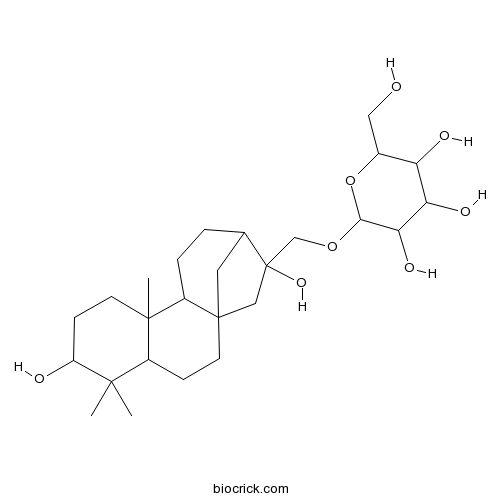Suavioside ACAS# 133740-37-1 |

Quality Control & MSDS
3D structure
Package In Stock
Number of papers citing our products

| Cas No. | 133740-37-1 | SDF | Download SDF |
| PubChem ID | 73821014 | Appearance | Powder |
| Formula | C26H44O8 | M.Wt | 484.63 |
| Type of Compound | Diterpenoids | Storage | Desiccate at -20°C |
| Solubility | Soluble in Chloroform,Dichloromethane,Ethyl Acetate,DMSO,Acetone,etc. | ||
| SMILES | CC1(C2CCC34CC(CCC3C2(CCC1O)C)C(C4)(COC5C(C(C(C(O5)CO)O)O)O)O)C | ||
| Standard InChIKey | KCTSUIMXVGYXPH-UHFFFAOYSA-N | ||
| Standard InChI | InChI=1S/C26H44O8/c1-23(2)16-6-9-25-10-14(4-5-17(25)24(16,3)8-7-18(23)28)26(32,12-25)13-33-22-21(31)20(30)19(29)15(11-27)34-22/h14-22,27-32H,4-13H2,1-3H3 | ||
| General tips | For obtaining a higher solubility , please warm the tube at 37 ℃ and shake it in the ultrasonic bath for a while.Stock solution can be stored below -20℃ for several months. We recommend that you prepare and use the solution on the same day. However, if the test schedule requires, the stock solutions can be prepared in advance, and the stock solution must be sealed and stored below -20℃. In general, the stock solution can be kept for several months. Before use, we recommend that you leave the vial at room temperature for at least an hour before opening it. |
||
| About Packaging | 1. The packaging of the product may be reversed during transportation, cause the high purity compounds to adhere to the neck or cap of the vial.Take the vail out of its packaging and shake gently until the compounds fall to the bottom of the vial. 2. For liquid products, please centrifuge at 500xg to gather the liquid to the bottom of the vial. 3. Try to avoid loss or contamination during the experiment. |
||
| Shipping Condition | Packaging according to customer requirements(5mg, 10mg, 20mg and more). Ship via FedEx, DHL, UPS, EMS or other couriers with RT, or blue ice upon request. | ||
| Description | 1. Suavioside A tastes sweet, it could be used as a sweetener. |

Suavioside A Dilution Calculator

Suavioside A Molarity Calculator
| 1 mg | 5 mg | 10 mg | 20 mg | 25 mg | |
| 1 mM | 2.0634 mL | 10.3171 mL | 20.6343 mL | 41.2686 mL | 51.5857 mL |
| 5 mM | 0.4127 mL | 2.0634 mL | 4.1269 mL | 8.2537 mL | 10.3171 mL |
| 10 mM | 0.2063 mL | 1.0317 mL | 2.0634 mL | 4.1269 mL | 5.1586 mL |
| 50 mM | 0.0413 mL | 0.2063 mL | 0.4127 mL | 0.8254 mL | 1.0317 mL |
| 100 mM | 0.0206 mL | 0.1032 mL | 0.2063 mL | 0.4127 mL | 0.5159 mL |
| * Note: If you are in the process of experiment, it's necessary to make the dilution ratios of the samples. The dilution data above is only for reference. Normally, it's can get a better solubility within lower of Concentrations. | |||||

Calcutta University

University of Minnesota

University of Maryland School of Medicine

University of Illinois at Chicago

The Ohio State University

University of Zurich

Harvard University

Colorado State University

Auburn University

Yale University

Worcester Polytechnic Institute

Washington State University

Stanford University

University of Leipzig

Universidade da Beira Interior

The Institute of Cancer Research

Heidelberg University

University of Amsterdam

University of Auckland

TsingHua University

The University of Michigan

Miami University

DRURY University

Jilin University

Fudan University

Wuhan University

Sun Yat-sen University

Universite de Paris

Deemed University

Auckland University

The University of Tokyo

Korea University
- Ebenifoline E-II
Catalog No.:BCN3097
CAS No.:133740-16-6
- GSK 2193874
Catalog No.:BCC8009
CAS No.:1336960-13-4
- 1-Allyl-3,5-Dimethylpyrazole
Catalog No.:BCC8450
CAS No.:13369-74-9
- Exoticin
Catalog No.:BCN6182
CAS No.:13364-94-8
- 2-Aminoisonicotinic acid
Catalog No.:BCC8550
CAS No.:13362-28-2
- 2-Ethyl-2,6,6-trimethylpiperidin-4-one
Catalog No.:BCN6504
CAS No.:133568-79-3
- Fmoc-Ile-ol
Catalog No.:BCC2584
CAS No.:133565-46-5
- Boc-Threoninol(Bzl)
Catalog No.:BCC2704
CAS No.:133565-43-2
- Boc-Glutaminol
Catalog No.:BCC3092
CAS No.:133565-42-1
- Isoatriplicolide tiglate
Catalog No.:BCN7934
CAS No.:133559-39-4
- 4,15-Isoatriplicolide methylacrylate
Catalog No.:BCN7935
CAS No.:133559-38-3
- AG 556
Catalog No.:BCC6720
CAS No.:133550-41-1
- GSK2606414
Catalog No.:BCC1606
CAS No.:1337531-36-8
- GSK2656157
Catalog No.:BCC4983
CAS No.:1337532-29-2
- Dysolenticin J
Catalog No.:BCN7497
CAS No.:1337973-08-6
- Manninotriose
Catalog No.:BCN8488
CAS No.:13382-86-0
- LIMKi 3
Catalog No.:BCC7972
CAS No.:1338247-35-0
- SR 1664
Catalog No.:BCC6166
CAS No.:1338259-05-4
- Pseudolarolide Q2
Catalog No.:BCN8092
CAS No.:1338366-22-5
- EPZ004777
Catalog No.:BCC2218
CAS No.:1338466-77-5
- OTS514
Catalog No.:BCC4024
CAS No.:1338540-55-8
- OTS964
Catalog No.:BCC4025
CAS No.:1338545-07-5
- Safinamide
Catalog No.:BCC1915
CAS No.:133865-89-1
- Valnemulin HCl
Catalog No.:BCC4746
CAS No.:133868-46-9
Inhibitory Effect of Chemical Constituents Isolated from Artemisia iwayomogi on Polyol Pathway and Simultaneous Quantification of Major Bioactive Compounds.[Pubmed:28512639]
Biomed Res Int. 2017;2017:7375615.
Blocking the polyol pathway plays an important role preventing diabetic complications. Therefore, aldose reductase (AR) and advanced glycation endproducts (AGEs) formation has significant effect on diabetic complications. Artemisia iwayomogi has long been used as treatment of various diseases in Korea. However, no literatures have reported on AR and AGEs formation inhibitory activities of A. iwayomogi. For these reasons, we aimed to assess that A. iwayomogi had potential as anti-diabetic complications agents. We led to isolation of two coumarins (1 and 2), nine flavonoids (3-11), five caffeoylquinic acids (12-16), three diterpene glycosides (17-19), and one phenolic compound (20) from A. iwayomogi. Among them, hispidulin (4), 6-methoxytricin (6), arteanoflavone (7), quercetin-3-gentiobioside (10), 1,3-di-O-caffeoylquinic acid (13), and Suavioside A (18) were first reported on the isolation from A. iwayomogi. Not only two coumarins (1 and 2), nine flavonoids (3-11), and five caffeoylquinic acids (12-16) but also extracts showed significant inhibitor on AR and AGEs formation activities. We analyzed contents of major bioactive compounds in Korea's various regions of A. iwayomogi. Overall, we selected Yangyang, Gangwon-do, from June, which contained the highest amounts of bioactive compounds, as suitable areas for cultivating A. iwayomogi as preventive or therapeutic agent in the treatment of diabetic complications.


